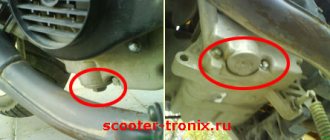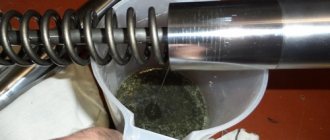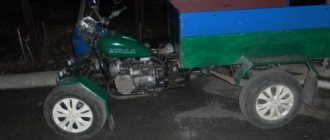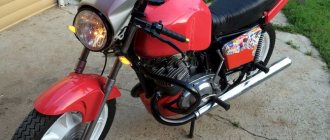The gearbox oil should be replaced after the first 500 km, and then every 10,000 thousand km.
It is better to change the oil immediately after a trip, while it is hot.
1. Place the motorcycle on the center stand.
2. We place a wide container with a volume of 1.5-2 liters under the engine crankcase.
3. 22 mm
Unscrew the drain plug located at the bottom of the crankcase and drain the oil.
When the bulk of the oil has flowed out, tilt the motorcycle slightly to the right side so that the oil completely flows out of the engine transmission compartment.
4. Close the drain plug.
5. Using a slotted screwdriver, loosen the rear screw securing the hatch-emblem on the left crankcase cover, and unscrew the front screw completely.
6. Turn the hatch on the rear screw, opening the window in the crankcase cover. Fill the crankcase with a liter of engine oil.
For convenience, you can tilt or lay the motorcycle on the right side.
7. Close the hatch and tighten the screws that secure it. Wipe off any oil stains from the crankcase surface.
The use of gear oil for a motorcycle gearbox is undesirable. Due to the higher viscosity of transmission oil, especially in cold weather and after a long stay, it is possible for the clutch discs to “stick together” with the corresponding consequences (the clutch does not disengage at all or “drives”).
If the oil drained from the gearbox is heavily contaminated, has a dark color and metal particles are clearly visible in it, it is recommended to flush the gearbox before adding fresh oil. To do this, pour about 0.5 liters of a mixture of any clean motor or transmission oil into the crankcase in half with kerosene, white spirit or diesel fuel. Having hung the rear wheel, we start the engine and, changing gears, “twist” the gearbox for 2-3 minutes, washing it. After this, quickly drain the flushing mixture and pour fresh oil into the gearbox.
How much oil does a chainsaw need per liter of gasoline?
To refuel you will need 92 gasoline and special oil for two-stroke air-cooled engines. Prepare the mixture in the proportion of oil and gasoline - 1:40. In other words, we maintain the ratio for 1 liter of gasoline - 25 grams of oil.
Interesting materials:
What is the weight of a Cossack? What is the boxing weight? How much weight can an adult bike bear? What is the weight of an adult panda? Who is the UFC featherweight champion? Who is the lightweight champion now? Why am I gaining weight? Why do you lose weight in summer? Why do I weigh more in summer? Why do bathroom scales show different weights in different places?
Izh Jupiter 5 where does the engine oil go? | Topic author: Veronica
Nina Stout correctly wrote that to lubricate the engine, oil is mixed with gasoline in a ratio of 1:20.
Separately, oil is poured into Vadim’s gearbox. I’ll just clarify a little: in Izh Jupiter 5, oil is poured not from the right side but from the left, not from above but from the side Ilya, and there is no control screw there, there is a dipstick on the mentioned cap. More oil is poured into the flywheel cavity. For filling into the flywheel cavity, there is a screw plug with a slot for a screwdriver on the left half of the engine, near the engine mounting point. You need to put the motorcycle on a flat surface, unscrew this plug and pour Leonid oil into the hole so that the oil is flush with the edge of the Oksana hole. Konstantin Oil must be mixed into gasoline
Ekaterina Oil is poured into the box from the top right side, on the side on the same side there is a control screw. Oil is not poured into the engine, but mixed with gasoline in a ratio of 1:20. Read the instructions.
Vladislav If you want to pour it into the engine, then try through the muffler
Maria On the left Izh has a rubber piece on the engine and it says Izh you unscrew it and it fills in there
>> Periodic maintenance. Gearbox - oil change
LLC “World of Autobooks”
Gearbox - oil change
The gearbox oil should be replaced after the first 500 km, and then every 10,000 thousand km.
It is better to change the oil immediately after a trip, while it is hot.
1. Place the motorcycle on the center stand.
2. We place a wide container with a volume of 1.5 - 2 liters under the engine crankcase.
3. Using a 22 mm wrench, unscrew the drain plug located at the bottom of the crankcase and drain the oil.
When the bulk of the oil has flowed out, tilt the motorcycle slightly to the right side so that the oil completely flows out of the engine transmission compartment.
4. Screw in the drain plug
5. Using a slotted screwdriver, loosen the rear screw securing the hatch-emblem on the left crankcase cover, and unscrew the front screw completely.
6. Turn the hatch on the rear screw, opening the window in the crankcase cover. Fill the crankcase with a liter of engine oil.
For convenience, you can tilt or lay the motorcycle on the right side.
7. Close the hatch and tighten the screws that secure it. Wipe off any oil stains from the crankcase surface.
Attention!
The use of gear oil for a motorcycle gearbox is undesirable. Due to the higher viscosity of transmission oil, especially in cold weather and after a long stay, it is possible for the clutch discs to “stick together” with the corresponding consequences (the clutch does not disengage at all or “drives”).
If the oil drained from the gearbox is heavily contaminated, has a dark color and metal particles are clearly visible in it, it is recommended to rinse the gearbox before adding fresh oil. To do this, pour about 0.5 liters of a mixture of any clean motor or transmission oil into the crankcase in half with kerosene, white spirit or diesel fuel. Having hung the rear wheel, we start the engine and, changing gears, “twist” the gearbox for 2-3 minutes, washing it. After this, quickly drain the flushing mixture and pour fresh oil into the gearbox.
Planet-5 gearbox repair
The gearbox is repaired after disassembling the gearbox. At this stage, the cause of the malfunction is identified and the necessary parts are replaced. At the same time, it is best to buy parts as a set, so there will be no discrepancies in size during assembly of the unit. If you follow the instructions given above, you can easily repair the gearbox yourself. For convenience, parts can be signed during disassembly. They should be laid out on a clean surface to prevent foreign bodies from getting into the structure in the future.
The result depends on the quality of the work performed. Therefore, it is important to carefully monitor the implementation of all points for assembling the gearbox with new parts, with the help of which the old ones were replaced.
Installation of bearings and seals
We install a retaining ring in the left half of the crankcase.
Depending on the model of the main oil seal, we install a spacer sleeve in the mounting hole of the main bearing, or, if the oil seal was initially wide (there are some), we heat the crankcase and, on the inside of the crankcase, place the oil seal until it stops against the retaining ring.
My engine had a regular narrow oil seal, so I put in a bushing.
Using a mandrel, install the main oil seal into the preheated crankcase.
Quickly, before the crankcase cools down, place the oil guide washer on the oil seal. The oil guide washer has a saucer-shaped profile. We place it on the oil seal so that the concave side faces us, and the curved side faces the clutch basket.
While the crankcase has not cooled down, we press the outer race of the main bearing into it using a mandrel.
If you are going to replace the main bearings with new ones, don’t be lazy: find a sheet of iron 7-8 mm thick, cut a wedge in it for the connecting rod, pass the sheet of iron between the cheeks of the crankshaft and use a mandrel to drive the main bearing onto the axle.
This way you will protect yourself from damage to the crankshaft. The main bearing has a very high interference and fits into the axle with a very large force. It is not uncommon for people to simply knock out the axle (the axle on the planetary crankshaft is pressed into the cheek) inside the crankshaft, but they were never able to put the bearing on.
Native made in USSR 2505 KM
Izh motorcycle engine oil - how often to change
The engine oil in IZH motorcycle engines must be changed every 5 thousand km or earlier, depending on how quickly the lubricant loses its useful properties. Signs of deteriorating fluid quality are insufficient oil level, cloudiness, wear debris in the form of sediment, and a burning smell. The shelf life of the lubricant can be negatively affected by intense driving with sharp maneuvers, sudden starts and braking, frequent off-road travel and towing heavy trailers. All this puts a significant load on the engine, which overheats, and spoiled oil is not able to effectively lubricate and cool the internal combustion engine parts.
Preparing for assembly
Preparation for assembly can be divided into two main stages: measuring and, if necessary, eliminating the axial play of the tracer shaft and checking the suitability of the secondary shaft bearing for further operation.
The first stage is measuring and eliminating the axial play of the copy shaft
We put adjusting washers on the tracking shaft from the locking side. In my case, there were four adjusting washers, but you may have more or less, or maybe not... We move the locking bar to the side and install the copy shaft in its place. We put a standard thrust washer on the second end of the tracing shaft.
We place a new gasket (required) on the plane of the gearbox cover connector, on which you will later finally assemble the gearbox, and tighten the gearbox cover fastening screws with the required force.
We turn the engine over and measure the axial play of the copy shaft, the norm is 0.2-0.4 mm, but it will be better if you can ensure the axial play at a level of no more than 0.2 mm. Adjustment of axial play is accomplished by simply adding or removing shims.
I measure the play with an indicator. If you don’t have one, try measuring the backlash with a caliper; if you don’t have a caliper, so be it - measure by eye...
Second stage: checking the suitability of the secondary shaft for further use
Under normal operating conditions, the secondary shaft bearing runs for quite a long time. But no matter how much we want and try, it wears out. It would be nothing if it weren’t for safety: if your secondary shaft bearing falls apart while driving, and it will certainly fly apart if you don’t change it in time, the gearbox sticks together with the rear wheel, and it’s tight and you’re grinding the asphalt with your butt...
Carefully, take out the secondary shaft over some tray and carefully inspect the shaft bearing raceway, the races and the rollers themselves. The working surfaces of the bearing and rollers should be free of holes, edges, signs of wear or overheating. The path must have a perfectly flat working surface.
Example of a secondary shaft race and race in perfect condition.
To facilitate reassembly, apply some kind of lubricant, such as lithol, to the treadmill and carefully place the rollers on the track and, turning it a little, insert the shaft into the cage. As soon as the sprocket splines rest against the edge of the oil seal, use a thin screwdriver in a circle to straighten the edge of the oil seal and push the shaft until it stops. And immediately, so that the shaft does not fall out, put the sprocket on it and secure it with a nut.
Common faults
The most common problem with IZ Planet 5 is the spontaneous switching off of second gear. This problem is common on many other motorcycles, but this breakdown is often associated with careless gear shifting. When the first gear “spins” to high speeds, bypassing the “neutral” gear, the engagement with the second speed gear causes an impact, which causes wear. To prevent such a malfunction, it is not recommended to spin the first gear too much. But if the second one still dies, then some ways to eliminate the problem are possible:
The simplest method that will help in some cases. Place the motorcycle on its right side, then remove the kick starter and gear shift lever along with the shaft. Then remove the left crankcase cover, and then remove the clutch basket along with the discs. During operation, the gearbox gears wear out, which causes the meshing of the teeth to deteriorate. This leads to slipping and jerking of the transmission until the second gear fails. Sometimes, when replacing a gear, the problem is not always solved, and lies in the wear of the bearings of the input shaft, which moves to the left over time due to vibrations. To fix the problem, you need to remove the stopper of the input shaft bearing, then move this bearing with light blows of a mallet or with a hammer through the “spacer”, so as to move the shaft to the right. To fix it in this position, you should place washers of appropriate diameter under the bearing. Using the number and thickness of washers, ensure that there is no play in the input shaft, then return the bearing stopper to its place, reassemble the clutch basket and other parts in the reverse order.
- If fourth gear disappears. This is often due to failure of the secondary shaft bearings. This is due to the appearance of axial play in the secondary shaft when the bearings are displaced or fail. This malfunction can be repaired in the same way as repairing the second gear by removing the left crankcase cover.
- If the gear shift jams from upshift to downshift, the spring of the shift mechanism pawls has broken and must be replaced.
- If the gearbox switches tightly after assembly, it indicates incorrect installation of the adjusting washers.
We would like to warn you right away: you should mark and write down the previous location of the adjusting washers when dismantling the switching mechanism.
Model features
The main feature of the motorcycle is that it can be used with or without a side trailer. If we look at the design, it resembles the IZH Planet 5. A distinctive feature is the simplicity and beauty of the style, unique cylinder fins and completely new flange mounts on the exhaust pipes have appeared. The shape of the dashboard has become square, there is also a turn signal, low/high beam, ignition switch and speedometer. Due to the increase in seating, the shape of the tank has also changed.
The peculiarity of the model lies in the parameters related to weight and dimensions:
- The ground clearance in different versions is 13.5 cm.
- Wheelbase – 145 cm.
- The length of the motorcycle is 217 cm.
- Full width 81.5 cm.
- Height 117 cm.
The weight of the Izh Jupiter 5 motorcycle reaches 160 kg, this helps the vehicle to be stable and maneuverable. If a side trailer is attached to the model, then the weight becomes 255 kg. The motorcycle can easily withstand a load of not only 170 kg, it can easily transport heavy loads, and there is no risk of wear and tear.
On the market Izh Jupiter 5 can be found in three modifications:
- The standard model is a motorcycle without a side trailer, but with mounts for a sidecar if necessary.
- The tourist model is equipped with a stroller and has an additional spare wheel with special lugs.
- Izh Jupiter 5 luxury class comes without a side trailer and has no fastenings. But there is a compact fairing and several knee roll bars. Additionally, this model has a trailer rack.








